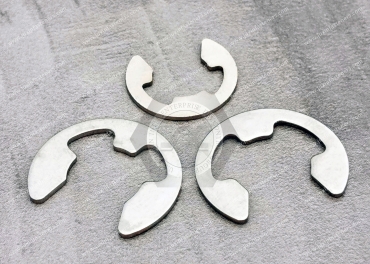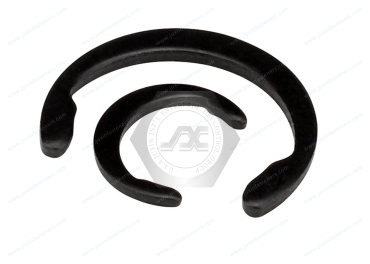Call Us
+86 136 6007 9809
Call Us
+86 136 6007 9809
Oct. 24, 2023
Shaft retaining rings limit axial and rotational displacements, prevent shafts from shifting or wobbling when in use, and prevent shafts from breaking or deforming when subjected to external forces. Retaining rings are usually made of metal or plastic materials and are characterized by wear, corrosion, and high-temperature resistance; they are suitable for various mechanical equipment and industrial applications.
A-type shaft retaining ring is a common mechanical element widely used in various devices, especially when quick connection and disconnection are required.
The basic structure of retaining ring: A-type shaft retaining ring consists of an inner ring, outer ring, and several elastic claws. The dimensions of the inner and outer rings are usually matched to the shaft bore and the mating dimensions on the shaft to ensure firmness during assembly. The elastic jaws clamp and release the shaft, keeping the device connected or disconnected.
The working principle of the elastic claw
1. The material of the elastic jaws is usually chosen from high-strength flexible alloy steel, which has good elasticity and wear resistance. They can withstand high-frequency assembly and disassembly operations without damage.
2. When no external force is applied, the elasticity naturally extends and forms a circular shape with the wall of the shaft hole, making it impossible to free the shaft.
3. When an external force is applied so that the shaft has a radial thrust relative to the retaining ring, the elasticity begins to flex, generating an inward force and releasing it from the shaft, realizing the shaft's release.
4. When the external force is removed, the elastic resumes its original shape and clamps the shaft again, ensuring a stable connection of the equipment.
Usage Scenarios of Retaining Ring (A-type shaft retaining ring is widely used in various mechanical devices)
Mechanical transmission system: This system connects parts such as gears, chains, and belts to transmit power and torque.
Power tools: Used to fix cutting tools and abrasives to ensure their stability and safety.
Automobile manufacturing: Used to connect wheels and axles to realize driving and steering functions.


What are the types of shaft retaining rings?
1. External Retaining Rings
Open these rings, pass them over the end of a shaft, and release them to spring into the groove. Ring ID is measured by the ring being uninstalled. Use retaining ring pliers (sold separately) to install and remove rings.
1060-1090 spring steel rings are an economical choice with good strength. A black-phosphate finish is mildly corrosion-resistant in dry environments. In wet environments, a zinc yellow-chromate-plated finish has some corrosion resistance, and a zinc chromate-plated finish has good corrosion resistance.
2. Heavy Duty External Retaining Rings
Thicker than standard external retaining rings, these rings withstand more significant force. Open them with retaining ring pliers (sold separately), pass them over the end of a shaft, and release them to spring into the groove. Ring ID is measured by the ring being uninstalled.
1060-1090 spring steel rings are an economical choice with good strength.
3. Mil. Spec. External Retaining Rings
These rings meet military specification MS16624. Open them with retaining ring pliers (sold separately), pass them over the end of a shaft, and release them to spring into the groove. Ring ID is measured by the ring being uninstalled.
4. Inverted External Retaining Rings
The lugs on these rings point inward for a smooth profile and better clearance than standard external retaining rings. Open them with retaining ring pliers (sold separately), pass them over the end of a shaft, and release them to spring into the groove. Ring ID is measured by the ring being uninstalled. The black-phosphate finish is mildly corrosion-resistant in dry environments.
Thrust load capacity, or PR, uses a more rigid shaft than the ring.
Metric rings meet DIN 471 specifications for retaining ring grooves.
5. Self-Locking External Retaining Rings
These light—duty rings do not require a groove, and their thick profile helps them grip the shaft. Open them with retaining ring pliers (sold separately), pass them over the end of a rod, and release them to install. Ring ID is measured by the ring being uninstalled.
6. Side-Mount External Retaining Rings
Also known as E-style rings, these rings have three prongs that make contact with the shaft and provide a wider shoulder than other external rings for a larger retaining surface. Use a side-mount retaining ring tool (sold separately) to push them into the groove from the side of the shaft. Ring OD is measured when the ring is uninstalled.
Advantages of using retaining rings
Quick connection and disconnection: Retaining rings allow the shaft to be clamped and released quickly, increasing the efficiency of equipment assembly and maintenance.
Stable connection: The retaining ring's grip on the shaft ensures that the equipment remains stably connected during operation, avoiding shaft loosening and dislodging.
Routine maintenance: The retaining ring's simple structure makes it easy to maintain and replace without the need for specialized tools.
As a standard mechanical device, an A-type shaft retaining ring has the advantages of quick connection and disconnection, solid connection, and convenient maintenance. The working principle of the elastic claw realizes the clamping and releasing of the shaft and is widely used in various mechanical devices. Retaining rings will continue to play an essential role in the engineering design and production.
If you are looking for high-quality fastener screws & all kinds of washers or technical support for structural design, please get in touch with me. Thanks. Email: adelajonly@gmail.com Website: www.juxinfasteners.com
Contact Us
Tel.:
+86 020 8621 0320
+86 020 3121 6067
Technical Support:
Navigation
SEND INQUIREY